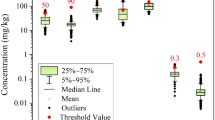Abstract
Many kinds of uncertainties are involved, such as random, fuzzy, grey, unascertained property and so on, in soil erosion process. To exactly predict the non-point source pollution loads, some uncertainties should be taken into consideration. Aiming at the deficiency of present blind number theory being helpless for fuzziness, a novel blind number, i.e. extended-blind number, was introduced by substituting a set of triangular fuzzy numbers (TFNs), expressed as α-cuts, for interval values in present blind number, and the expected value of extended-blind number was also brought forward by referring to the current blind number theory. On the basis of denoting the parameters of Universal Soil Loss Equation (USLE) as extended-blind parameters, a novel USLE model was established for quantitatively evaluating soil erosion loss and non-point source pollution loads. As a case, the uncertain USLE was employed for predicting the soil erosion loss and non-point source pollution loads of absorbed nitrogen and phosphorus in a district in the Hangbu-Fengle River basin, in the upstream of Chaohu Lake watershed. The results show that it is feasible in theory to extend blind number into fuzzy environment and reliable on conclusion to apply extended-blind number theory for predicting non-point source pollution loads.
Similar content being viewed by others
References
Cheng Haozhong, Zhu Haifeng, Crow M L et al., 2004. Flexible method for power network planning using the unascertained number. Electric Power Systems Research, 68(1): 41–46. DOI: 10.1016/s0378-7796(03)00108-1.
Hu Lianwu, Wang Xuejun, Luo Dinggui et al., 2007. Effect of subwatershed partitioning on flow, sediment and nutrient prediction: Case study Fengle River watershed. Advances in Water Science, 18(2): 235–240. (in Chinese)
Huang Hongnu, Hua Xisheng, Weng Jingjun, 2004. Comprehensive assessment method based on blind information theory in earth rock dam. Journal of Yangtze River Scientific Research Institute, 21(5): 59–62. (in Chinese)
Huang Jinliang, Hong Huasheng, Zhang Luobing et al., 2004. Study on predicting soil erosion in Jiulong River watershed on GIS and USLE. Journal of Soil and Water Conservation, 18(5):75–79. (in Chinese)
Jiang Ying, Wang Xuejun, Hu Lianwu et al., 2007. Agricultural non-point pollution control under watershed total load control and risk analysis of control scenarios-practices on watershed of Hangbu-Fengle River. Journal of Agricultural Environmental Science, 26(3): 807–812. (in Chinese)
Jin Xiangcan, Tu Qingying, 1990. Survey norms for lake eutrophication. Beijing: China Environmental Science Press, 101–108. (in Chinese)
Kentel E, Aral M M, 2005. 2D Monte Carlo versus 2D fuzzy Monte Carlo health risk assessment. Stochastic Environmental Research and Risk Assessment, 19(1): 86–96. DOI: 10.1007/s00477-004-0209-1
Li Ruzhong, 2006. Multi-agent blind model and its application to regional eco-environmental quality assessment. Chinese Geographical Science, 16(3): 249–254. DOI: 10.1007/s11769-007-0127-5
Li Ruzhong, 2007a. Research on eco-environment and control mechanism of eutrophication in Chaohu Lake. Hefei: Hefei University of Technology. (in Chinese)
Li Ruzhong, 2007b. Calculation of basin soil erosion load based on fuzzy theory. Environmental Science and Technology, 30(3): 24–26. (in Chinese)
Li Ruzhong, Qian Jiazhong, Sun Shiqun et al., 2005. Calculation of basin soil erosion load according to uncertain information. Journal of Hydraulic Engineering, 36(1): 89–94. (in Chinese)
Liu Kaidi, Wu Heqin, Pang Yanjun et al, 1999. Mathematical Treatment and Application of Uncertain Information. Beijing: Science Press, 20–95. (in Chinese)
Lu Yongsen, 1999. Environmental Assessment. Shanghai: Tongji University Press, 431–435. (in Chinese)
Mehran H, 2004. Bridging the gap between probabilistic and fuzzy-parameter EOQ models. International Journal of Production Economics, 91(3): 215–221. DOI: 10.1016/j.ijpe.2003.08.011
Mitra B, Scott H D, Dixon J C et al., 1998. Application of fuzzy logic to the prediction of soil erosion in a large watershed. Geoderma, 86(3–4): 183–209. DOI: 10.1016/s0016-7061(98)00050-0.
Novotny V, Chesters G, 1981. Handbook of Nonpoint Pollution: Sources and Management. New York: Van Nostrand Reinhold Co., 65–81.
Olson D L, Wu Desheng, 2006. Simulation of fuzzy multiattribute models for grey relationships. European Journal of Operational Research, 175(1): 111–120. DOI: 10.1016/j.ejor.2005.05.002.
Ronald E G, Robert E Y, 1997. Analysis of the error in the standard approximation used for multiplication of triangular and trapezoidal fuzzy numbers and the development of a new approximation. Fuzzy Sets and Systems, 91(1): 1–13. DOI: 10.1016/s0165-0114(96)0018-2.
Sun Lining, 2005. Analysis of nonpoint sources pollution in the watershed on the basis of WARMF Model—Taking Hangbu-Fenglr River watershed as example. Hefei: Hefei University of Technology. (in Chinese)
Tran L T, Ridgley M A, Duckstein L et al., 2002. Application of fuzzy logic-based modeling to improve the performance of the Revised Universal Soil Loss Equation. Catena, 47(3): 203–226. DOI: 10.1016/s0341-8162(01)00183-7.
Wang Guangxing, Gertner G, Liu Xianzhong et al., 2001. Uncertainty assessment of soil erodibility factor for revised universal soil loss equation. Catena, 46(1): 1–14. DOI: 10.1016/s0341-8162(01)00158-8
Wang Jianyun, 2001. Calculation of pollution load in Xinyuan Lake watershed by general purpose leaching equation. Environmental Engineering, 19(4): 54–56. (in Chinese)
Wang Xiaohui, 2006. Estimation and control of non-point source pollution loads of nitrogen and Phosphorus in Lake Chaohu Basin. Hefei: Hefei University of Technology. (in Chinese)
Yang Zhimin, 2000. Review of the monographs: Mathematical treatment and application of uncertain information. Chinese Science Bulletin, 46(7): 615–616.
Yu Hong, Shen Zhenyao, 2007. Analyzing parameter uncertainty of the non-point source pollution in Daning River of the Three Gorges Reservoir area. China Environmental Science, 27(4):433–436. (in Chinese)
Zhang Ji, Yu Sujun, 2007. Risk analysis on Groundwater resources carrying capacity based on blind number theory. Wuhan University Journal of Natural Sciences, 12(4): 669–676. DOI: 10.1007/s11859-006-0337-1
Zhang K L, Shu A P, Xu X L et al., 2008. Soil erodibility and its estimation for agricultural soils in China. Journal of Arid Environments, 72(6): 1002–1011. DOI: 10.10116/j.jaridenv.2007.11.018
Zhang Sicong, Liu Minghuan, 2006. Calculation and analysis of the non-point source pollution of Zhuganhe watershed. Journal of Hydroelectric Engineering, 25(5): 51–57. (in Chinese)
Author information
Authors and Affiliations
Corresponding author
Additional information
Foundation item: Under the auspices of Tackling Key Program for Science and Technology of Anhui Province (No. 07010302165) and Natural Science Foundation of Anhui Province (No. 050450303)
Rights and permissions
About this article
Cite this article
Li, R. Estimation of non-point source pollution loads under uncertain information. Chin. Geogr. Sci. 18, 348–355 (2008). https://doi.org/10.1007/s11769-008-0348-2
Received:
Accepted:
Published:
Issue Date:
DOI: https://doi.org/10.1007/s11769-008-0348-2




